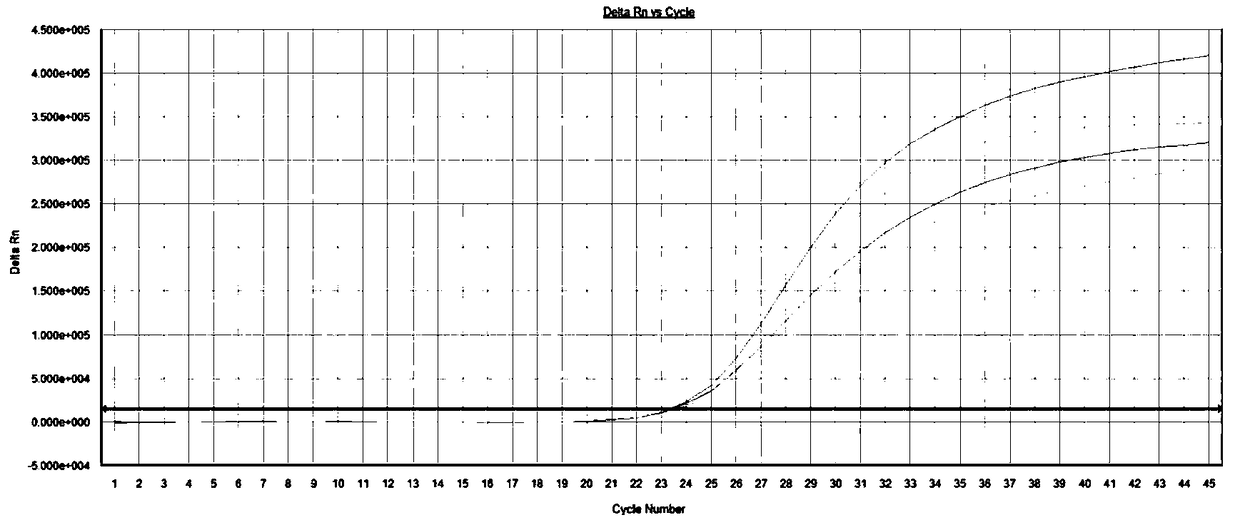Multiplex fluorescent PCR detection kit for periodontitis pathogenic bacteria
A detection kit and multiple fluorescence technology, which are applied in the determination/inspection of microorganisms, microorganisms, biochemical equipment and methods, etc., can solve the problems such as the detection of periodontitis pathogens that have not yet occurred.
- Summary
- Abstract
- Description
- Claims
- Application Information
AI Technical Summary
Problems solved by technology
Method used
Image
Examples
Embodiment 1
[0082] Example 1. Detection method of kit
[0083] 1.1 Sample collection: The sterile paper tip method is used to collect samples from the deepest part of the patient’s periodontal pocket or from the gingival sulcus of periodontal healthy persons. The specific collection method is as follows: After gargle with regular water, rinse with normal saline to remove food residues and blow Dry, moisturized cotton ball, topical disinfection with 2.5% iodine tincture cotton ball, insert a piece of sterile paper tip into the periodontal pocket or gingival sulcus, stop inserting when there is resistance, stay for 30s, take it out, and place it in a sterile centrifuge In the tube.
[0084] 1.2 Preparation of sample DNA: The kit of the present invention does not provide DNA sample extraction reagents, and users can choose a suitable commercial kit to extract sample nucleic acid.
[0085] 1.3 Preparation of the reaction body fluid: the reaction volume is 20μL; each sample takes 3 clean 0.5ml EP tu...
Embodiment 2
[0093] Example 2. Sensitivity analysis of the kit
[0094] 2.1 Template: Synthesize plasmid DNA containing amplicons as a template for detection, use a micro-ultraviolet spectrophotometer to determine the concentration of purified plasmid DNA, calculate the number of copies of the initial DNA template by molecular weight, and then make 10-fold gradient dilutions in sequence Up to the number of copies, a total of 7 gradients, the number of copies: 1 x 10 6 Up to 1 x 10 0 .
[0095] 2.2 PCR detection: Use the above detection method to prepare the reaction solution, and then place the reaction tube on the fluorescent PCR machine for amplification and detection. After the reaction is completed, observe the fluorescence curve chart and analyze the minimum number of template copies that can be detected by the above kit. The specific amplification curve is as follows Figure 4 ~ Figure 13 Shown.
[0096] 2.3 Results and analysis: by Figure 4 ~ Figure 13 It can be seen that the detection l...
Embodiment 3
[0098] Example 3: Detection of clinical samples of the kit
[0099] 3.1 Sample collection: use the above-mentioned sample collection method to collect infection with Actinobacillus, Porphyromonas gingivalis, Prevotella intermedius, Treponema denticola, Forsysteinella, Fusobacterium nucleatum, Campylobacter gracilis, rectum Samples of 10 major pathogenic bacteria of periodontitis of Campylobacter, Eubacterium entangled and Streptococcus constellation, and sample DNA was extracted.
[0100] 3.2 PCR detection: Use the above detection method to prepare the reaction solution, and then place the reaction tube on the fluorescent PCR machine for amplification and detection.
[0101] 3.3 Results and analysis: by testing samples 1 to 3, the test results are as follows Figure 14 ~ Figure 23 Shown.
[0102] by Figure 14 ~ Figure 23 It can be seen that using the above-mentioned PCR detection kit for periodontitis pathogens can detect all 10 main pathogens of periodontitis.
PUM
 Login to View More
Login to View More Abstract
Description
Claims
Application Information
 Login to View More
Login to View More - R&D
- Intellectual Property
- Life Sciences
- Materials
- Tech Scout
- Unparalleled Data Quality
- Higher Quality Content
- 60% Fewer Hallucinations
Browse by: Latest US Patents, China's latest patents, Technical Efficacy Thesaurus, Application Domain, Technology Topic, Popular Technical Reports.
© 2025 PatSnap. All rights reserved.Legal|Privacy policy|Modern Slavery Act Transparency Statement|Sitemap|About US| Contact US: help@patsnap.com



